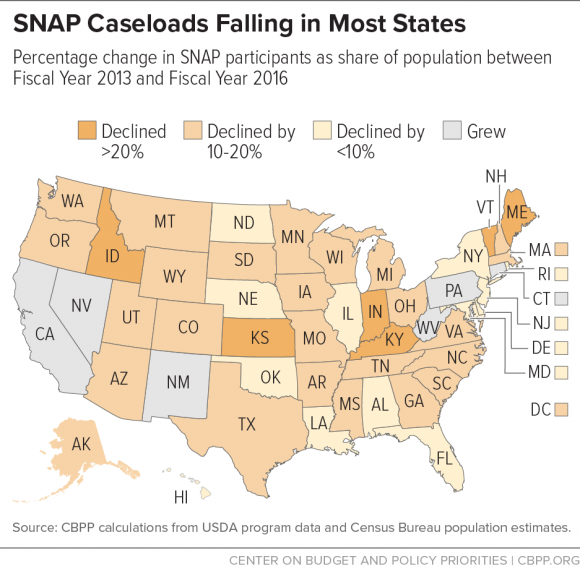BEYOND THE NUMBERS
SNAP Rolls Fell by 9 Percent Since 2012 Due to Economic Recovery and Time Limit
The number of people participating in the Supplemental Nutrition Assistance Program (SNAP, formerly food stamps, the nation’s most important anti-hunger program) has dropped by more than 4 million people, or 9 percent, since peaking in December 2012, our new paper explains. That is both because fewer Americans need SNAP due to an improving economy, and because a three-month SNAP time limit for unemployed childless adults has returned in most states. The share of the population participating in SNAP has returned to 2011 levels, and it’s projected to continue to fall. The SNAP caseload declines have been widespread; the share of the population receiving SNAP was lower in 2016 than in 2013 in 45 states.
SNAP spending also has fallen. SNAP outlays fell for the third straight year and were 4 percent lower in 2016 than in 2015. The only time since 2000 when SNAP spending declined faster was in 2014 when the 2009 Recovery Act’s temporary SNAP benefit boost ended. In 2016 SNAP spending dropped to its lowest point since 2010, and more than 11 percent below 2013 peak levels — and that’s in nominal, not inflation adjusted, dollars.
The improving economy likely explains most of the caseload decline, which makes the drop welcome. More troubling are the large declines that came in April 2016, as states re-implemented the three-month time limit. That’s likely causing serious hardship among many, since the average income of those affected is less than 20 percent of the poverty line.
Once the economy has fully recovered, SNAP costs are expected to rise only in response to growth in the size of the low-income population and increases in food prices. Unlike health care programs and Social Security, SNAP faces no demographic or programmatic pressures that will cause its costs to grow faster than the economy. Thus, SNAP will not contribute to the nation’s long-term fiscal problems. In fact, economists at the Congressional Budget Office and Moody’s Analytics consider SNAP, which provides a mere $1.35 per person per meal for households with children, one of the most effective forms of economic stimulus when the economy is weak.
SNAP caseloads grew during the recession both because more people qualified for help (due to the weak economy) and because a larger share of eligible people applied for and received benefits. With a recovering economy, a key long-term issue is whether states can maintain their progress in reaching eligible households.

